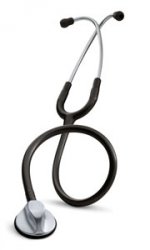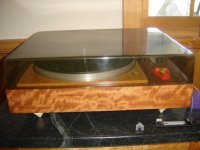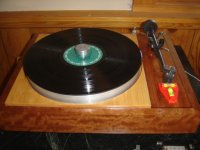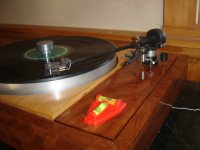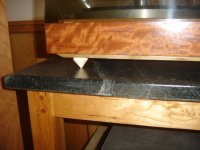This energy sinking thing will happen anyway up to a point I guess since a small mass (TT) rests on a large mass (house). You can try some methods for the best practical compromise. If it will lose definition with elastic, you keep the cones and you attack the stand.
I am in the process of making the elastic feet. My first design was a failure so we will move to generation 2 tomorrow. Never even was able to test the first ones.
Found out some intersting things as the result of some further exploritory tapping. During the gluing process of the wooden top plate, some epoxy sqeezed out against the tomearm board. It had become attached on one edge and was acting like a spring.
So I took it apart to get it to float on its isolation ring. The result was less sensitivity to tapping and the Q became broader. The sound however suffered, still good but not as detailed and slower feeling.
I have since temporarily rigidly coupled the tonearm board to the to the plinth top plate and the detail and speed improved to as good as it was before. Still less sensitive to tapping but i can't say that the feed through is eliminated.
Found out some intersting things as the result of some further exploritory tapping. During the gluing process of the wooden top plate, some epoxy sqeezed out against the tomearm board. It had become attached on one edge and was acting like a spring.
So I took it apart to get it to float on its isolation ring. The result was less sensitivity to tapping and the Q became broader. The sound however suffered, still good but not as detailed and slower feeling.
I have since temporarily rigidly coupled the tonearm board to the to the plinth top plate and the detail and speed improved to as good as it was before. Still less sensitive to tapping but i can't say that the feed through is eliminated.
Last edited:
Tapping is sending an impulse, so its intuitive. A stethoscope can reveal many things on the structure when tapping. I used it on speakers sometimes. If your family or friends see you wearing that and tapping, they will be taking the mickey for a long time though. Act secretly.
good point. Will act in an appropriate manner when people are around. Have to find my wifes stethoscope.
good point. Will act in an appropriate manner when people are around. Have to find my wifes stethoscope.
Hi,
you can use soft arrow points,instead of spikes or cones.These are made by relatively soft aluminum,or use small pieces of soft wood as feet,under the plinth,for the energy sinking to work best.
B.L
stethoscopes and such...
I use a Littmann Lightweight in all my audio adventures requiring one🙂
SGregory: I think you may have stumbled across something completely unintentional. If each component is effectively isolated from the other in a turntable system (arm, platter/bearing, motor, and plinth or support), some fairly odd things can happen. You can have too much damping and isolation. Kinda like MDF cabinets for loudspeakers. Yes, many people use it, to varying degrees of success, but almost everybody who I know who has used BB ply seems to universally have a good cabinet (assuming competently built in both situations).
I don't want to hijack this thread, and have it become a discussion/argument about suitability of materials for use in a loudspeaker or turntable. The bigger picture, particularly to this thread is how the subsystems of a turntable may (or may not) interact with each other.
Your design (I think) may be over dampened, much like MDF...it may suck the life out of the music.
I use a Littmann Lightweight in all my audio adventures requiring one🙂
SGregory: I think you may have stumbled across something completely unintentional. If each component is effectively isolated from the other in a turntable system (arm, platter/bearing, motor, and plinth or support), some fairly odd things can happen. You can have too much damping and isolation. Kinda like MDF cabinets for loudspeakers. Yes, many people use it, to varying degrees of success, but almost everybody who I know who has used BB ply seems to universally have a good cabinet (assuming competently built in both situations).
I don't want to hijack this thread, and have it become a discussion/argument about suitability of materials for use in a loudspeaker or turntable. The bigger picture, particularly to this thread is how the subsystems of a turntable may (or may not) interact with each other.
Your design (I think) may be over dampened, much like MDF...it may suck the life out of the music.
Not a hijack at all. I was hoping this thread would get into this discussion. Part of the learning experience. I absolutley agree about mdf and overdamped. I long ago moved away from MDF in cabinets for the above stated reason. I actually use real hardwood instead of ply based on my preference. Takes alot of precaution to get designs stable however.
By floating the tonearm board it absolutley does "suck the life out of the music". I also percieve it as being cloudy sounding. That was simple to fix however by coupling the board to the plinth with a couple of splints inserted into gaps. When rigid, the table is very clear, detailed, and dynamic.
I would like to see if I can measure the difference before I permanently rigidly affix the board to the plinth.
FYI, The idea I had of lead shot and silicone is not good. It has a built in resonance which seems to be determined by the K of the silicone and the weight of the individual BB shot. Not the total mass of BB's. IMHO, subjectivley, if mass is to be added it needs to be done very rigidly and coupled rigidly to the system. Or if dampening is desired, it needs to be done so the dampening particals are allowed to flow. i.e. sand.
By floating the tonearm board it absolutley does "suck the life out of the music". I also percieve it as being cloudy sounding. That was simple to fix however by coupling the board to the plinth with a couple of splints inserted into gaps. When rigid, the table is very clear, detailed, and dynamic.
I would like to see if I can measure the difference before I permanently rigidly affix the board to the plinth.
FYI, The idea I had of lead shot and silicone is not good. It has a built in resonance which seems to be determined by the K of the silicone and the weight of the individual BB shot. Not the total mass of BB's. IMHO, subjectivley, if mass is to be added it needs to be done very rigidly and coupled rigidly to the system. Or if dampening is desired, it needs to be done so the dampening particals are allowed to flow. i.e. sand.
Continuing work I have done the following:
1) Soft wooden feet. It is harder than it looks to turn a good cone of wood, but finally succeeded. The feet made an improvement. and reduced feedback.
2) Soapstone, although beautiful, is not a good material for table top with phono on it. Rings like a bell. I think it would be equally lousy as a plinth. Will attach dampners and stiffners to the backside to solve that. Will photograph it when done.
3) Biggest improvement so far has been to isolate the table top from the stand with silicone pads. Effectively the heavy top floats on the legs. Now, I get almost no thump or sound through the speakers when I tap on it. I can hear the top ring but that doesn't get to the pick-up and into the speakers.
Basically what I found, was that I had a vibration feedback loop from the table top -> TT - > pick-up -> amps -> speakers -> back to the stand -> back to the table top. The silicone pads decouple the TT from the loop. The TT and stand top has a very low resonance, down in the few Hz range. This also explains why previously when I tapped on the top I found a very tight Q in the resonance.
I will continue to play with this further and refine. I have also completed the new tonearm board out of the Acuna. I hope to install that in the next few days for evaluation.
In its current config, it is a very good sounding table. Detailed, quiet, with good sound stage. Bass has improved from previous table substantially. It is my opinion that with the lower noise, the depth of the soundstage is more vast.
P.S. Apparently I wasn't carefull enough while using the stethoscope. I got caught. Wife took her scope back to work.
1) Soft wooden feet. It is harder than it looks to turn a good cone of wood, but finally succeeded. The feet made an improvement. and reduced feedback.
2) Soapstone, although beautiful, is not a good material for table top with phono on it. Rings like a bell. I think it would be equally lousy as a plinth. Will attach dampners and stiffners to the backside to solve that. Will photograph it when done.
3) Biggest improvement so far has been to isolate the table top from the stand with silicone pads. Effectively the heavy top floats on the legs. Now, I get almost no thump or sound through the speakers when I tap on it. I can hear the top ring but that doesn't get to the pick-up and into the speakers.
Basically what I found, was that I had a vibration feedback loop from the table top -> TT - > pick-up -> amps -> speakers -> back to the stand -> back to the table top. The silicone pads decouple the TT from the loop. The TT and stand top has a very low resonance, down in the few Hz range. This also explains why previously when I tapped on the top I found a very tight Q in the resonance.
I will continue to play with this further and refine. I have also completed the new tonearm board out of the Acuna. I hope to install that in the next few days for evaluation.
In its current config, it is a very good sounding table. Detailed, quiet, with good sound stage. Bass has improved from previous table substantially. It is my opinion that with the lower noise, the depth of the soundstage is more vast.
P.S. Apparently I wasn't carefull enough while using the stethoscope. I got caught. Wife took her scope back to work.
Last edited:
Continuing work I have done the following:
1) Soft wooden feet. It is harder than it looks to turn a good cone of wood, but finally succeeded. The feet made an improvement. and reduced feedback.
2) Soapstone, although beautiful, is not a good material for table top with phono on it. Rings like a bell. I think it would be equally lousy as a plinth. Will attach dampners and stiffners to the backside to solve that. Will photograph it when done.
3) Biggest improvement so far has been to isolate the table top from the stand with silicone pads. Effectively the heavy top floats on the legs. Now, I get almost no thump or sound through the speakers when I tap on it. I can hear the top ring but that doesn't get to the pick-up and into the speakers.
Basically what I found, was that I had a vibration feedback loop from the table top -> TT - > pick-up -> amps -> speakers -> back to the stand -> back to the table top. The silicone pads decouple the TT from the loop. The TT and stand top has a very low resonance, down in the few Hz range. This also explains why previously when I tapped on the top I found a very tight Q in the resonance.
I will continue to play with this further and refine. I have also completed the new tonearm board out of the Acuna. I hope to install that in the next few days for evaluation.
In its current config, it is a very good sounding table. Detailed, quiet, with good sound stage. Bass has improved from previous table substantially. It is my opinion that with the lower noise, the depth of the soundstage is more vast.
P.S. Apparently I wasn't carefull enough while using the stethoscope. I got caught. Wife took her scope back to work.
Nice results,as it seems,by your description.Another working isolating gadget, is some length,say 1,1/2" to 2" ,and a φ of 1", of garden hose, used as feet,
three always,under the plinth.
(get another one. Stethoscope 😱)
B.L.
At a good Place.
The phenox has had a few changes recently and now is in a place at which I will keep it for a while. The major changes are primarily related to the tonearm board and it being rigidly coupled to the plinth.
I went to the acuna wood for board as I liked the wood and wanted to try a harder more dense material. Acuna is like a light ebony in its characteristics.
You can see the wooden cones. Made those from a piece of soft maple root I had in the stores. It is soft and doesn't ring at all when rapped on.
There is very little transfer of energy when the table top is knocked on. As expected the plinth has become a little move lively when tapped as the tonearm board is coupled to it.
In general the sound is very lively with good base. The table is very quiet given the parts used.
I may try in the future elastic feet but will make that change after I have listend to it for a while.
The phenox has had a few changes recently and now is in a place at which I will keep it for a while. The major changes are primarily related to the tonearm board and it being rigidly coupled to the plinth.
I went to the acuna wood for board as I liked the wood and wanted to try a harder more dense material. Acuna is like a light ebony in its characteristics.
You can see the wooden cones. Made those from a piece of soft maple root I had in the stores. It is soft and doesn't ring at all when rapped on.
There is very little transfer of energy when the table top is knocked on. As expected the plinth has become a little move lively when tapped as the tonearm board is coupled to it.
In general the sound is very lively with good base. The table is very quiet given the parts used.
I may try in the future elastic feet but will make that change after I have listend to it for a while.
Attachments
- Status
- Not open for further replies.
- Home
- Source & Line
- Analogue Source
- "The Phoenix" an Ariston Audio RD80 TT Rebuild
